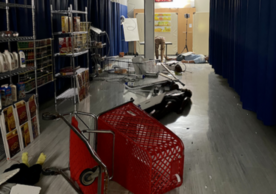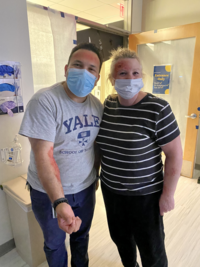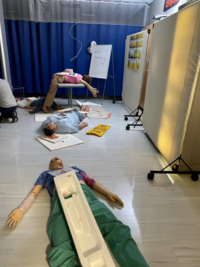
An explosion cracked the air, the intensity of the boom indicating proximity to today’s pizza oven demonstration at the nearby Piggly Wiggly. As the sirens started blaring, a triage team of Graduate Entry Prespecialty in Nursing (GEPN) students rushed to the scene of the annual mass-casualty simulation and surveyed the damage.
Psychiatric-Mental Health student Daniel Modlinger ’23 MSN felt immersed in the recent academic exercise right away.
“One moment we were sitting in the classroom discussing disaster triage, and then almost immediately we were thrust into a live movie!” he said. “They were definitely successful at getting my adrenaline pumping!”
Simulation Director Virginia “Ginger” Sherrick, MSN, APRN, FNP-BC, RN-BC, CHSE, CNE and her team designed a simulation, or “sim,” that included 12 victims, nine of whom are still alive when the sim begins and need to be assessed according to the Simple Triage and Rapid Treatment (START) method of colored tags. Victims were portrayed by a robust cast of mannequins and two live actors.
Responders use green, yellow, red, and black tags to communicate levels of need. Green tagged victims are ambulatory and ready for discharge; yellow tags signify that the person is stable enough for now and the response can be delayed; red tags convey that an immediate response is needed to save the victim’s life; and black tags are assigned to the deceased.
“In the area of the disaster, students are assessing acuity and what tag the victims need,” Sherrick said. “If they are tagged red and need immediate, life-saving procedures like applying a tourniquet or tilting the head because they’re not breathing, students provide it. Then the staging crew brings equipment to the scene, receives the victims to a safe area, and provides first aid.”
Making an Accurate Assessment
 One live actor exhibits signs of a head injury that are more extensive than they first appear. He’s not bruised or bleeding, and he’s talking just fine, so he initially presents as a green tag who can walk away. But answering questions is difficult for him, and it becomes clear that he’s confused and needs both a red tag and an immediate ambulance escort.
One live actor exhibits signs of a head injury that are more extensive than they first appear. He’s not bruised or bleeding, and he’s talking just fine, so he initially presents as a green tag who can walk away. But answering questions is difficult for him, and it becomes clear that he’s confused and needs both a red tag and an immediate ambulance escort.
The second live actor plays a mother frantically searching for her young son. She walks all over the place, and if the students don’t bring her to the staging area, she will distract the GEPNs from providing more urgently needed care to the red victims.
As Family Nurse Practitioner (FNP) student Sajni Persad ’23 MSN pointed out, providing care to someone like the searching mother requires more skill than correctly assessing a tag color.
“In such highly stressed situations, patients may need not just medical attention but empathy, care, and compassion,” Persad said. “Medical personnel are expected to move and tag patients quickly and efficiently, and after participating in this sim, I saw how easy it is to get caught up in our roles. As a result, one of the many takeaways that I took from this simulation is that no matter how stressful a mass-casualty event may be, I should always remember that the patients recently experienced a traumatic event. In order to provide quality care, we need to stay empathic to the patients’ needs, concerns, and fears.”
Debriefing the Sim
 After the exercise, the students, instructors and live actors debrief together. The mannequins generally don’t contribute much feedback.
After the exercise, the students, instructors and live actors debrief together. The mannequins generally don’t contribute much feedback.
Dr. Christine Rodriguez, DNP, APRN, FNP-BC, MDiv, MA, the newest member of the sim team, said these discussions cover not just technical proficiency and lessons learned, but also the ethical situations nurses face.
“The ethical concepts of beneficence and non-maleficence were brought up during multiple debrief sessions,” Rodriguez said. “For example, discussing whether to leave black-tagged deceased patients at the site of the event versus bringing them back with the other tagged patients. We talked about the psychological distress it would cause to the survivors, as well as whether to triage children first versus adults. We also discussed the desire to perform CPR to save lives first versus triaging first.”
Modlinger said the ethical conversation was deeply thought-provoking and described the exercise as a chance to learn how to focus during tough circumstances.
“The scenario really highlighted the importance of efficient communication,” Modlinger said. “As the staging officer it is imperative to gather information on the number and acuity level of the patients so that the staging area can be prepared adequately, and resources can be mobilized as needed. A lack of organized communication directly effects the patients’ chances of survival.”
Looking back on the experience, Persad praised the disaster sim’s design, execution, and results.
“Out of all of my GEPN sims, I appreciated this sim the most because, in spite of it being in a controlled setting, it felt like a real and safe mass-casualty scenario to put everything that I have learned thus far into use and practice,” she said. “As a visual and kinesthetic learner, the sim lab faculty and their creative sims have truly been so helpful for me because they safely immerse me into non-judgmental learning environments that provide me with the opportunities to learn from, be hands-on, and improve my ever-growing nursing skills.”
Previous Sim Disasters
Previous mass-casualty disaster simulations have included sifting through the aftermath of a tornado and collaborating with local police and emergency services teams to assess victims of a building collapse.
Apply Today!
This could be you next year. Applications are now open for the Fall of 2022 and close November 1. Learn more about GEPN and all our other programs on our Admissions page.
